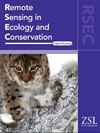HOWLish: a CNN for automated wolf howl detection
IF 4.3
2区 环境科学与生态学
Q1 ECOLOGY
引用次数: 0
Abstract
Automated sound‐event detection is crucial for large‐scale passive acoustic monitoring of wildlife, but the availability of ready‐to‐use tools is narrow across taxa. Machine learning is currently the state‐of‐the‐art framework for developing sound‐event detection tools tailored to specific wildlife calls. Gray wolves (HOWLish: CNN的自动狼嗥检测
自动声事件检测对于野生动物的大规模被动声学监测至关重要,但在不同的分类群中,现成的工具的可用性很窄。机器学习是目前最先进的框架,用于开发针对特定野生动物叫声的声音事件检测工具。灰狼(Canis lupus)是一种需要复杂管理的物种,它们会自发地嚎叫以进行长距离的群内和群间交流,这使它们成为被动声学监测的主要目标。然而,目前还没有经过预先训练的开放访问工具,可以在录制的音景中可靠地自动检测狼的嚎叫。我们收集了50 137小时的声景数据,其中我们手动标记了841个独特的嚎叫事件。我们使用该数据集对vggish(一种训练用于音频分类的卷积神经网络)进行微调,有效地将其重新训练用于狼嚎检测。HOWLish正确分类了我们测试集中77%的狼嚎样本,假阳性率为1.74%;尽管如此,由于极端的类别不平衡(7124:1),精确度很低(0.006)。在现场测试中,HOWLish能够检索到81.3%的嚎叫事件,同时与完全手动检测相比,操作员的时间减少了15倍。这项工作为开放获取的自动狼嚎检测建立了基线。HOWLish为野生狼种群的遥感研究提供了便利,为非侵入性大规模野生狼监测和交流研究提供了新的机遇。我们在这里解决的知识差距跨越了许多soniferous分类群,我们的方法也符合。
本文章由计算机程序翻译,如有差异,请以英文原文为准。
求助全文
约1分钟内获得全文
求助全文
来源期刊

Remote Sensing in Ecology and Conservation
Earth and Planetary Sciences-Computers in Earth Sciences
CiteScore
9.80
自引率
5.50%
发文量
69
审稿时长
18 weeks
期刊介绍:
emote Sensing in Ecology and Conservation provides a forum for rapid, peer-reviewed publication of novel, multidisciplinary research at the interface between remote sensing science and ecology and conservation. The journal prioritizes findings that advance the scientific basis of ecology and conservation, promoting the development of remote-sensing based methods relevant to the management of land use and biological systems at all levels, from populations and species to ecosystems and biomes. The journal defines remote sensing in its broadest sense, including data acquisition by hand-held and fixed ground-based sensors, such as camera traps and acoustic recorders, and sensors on airplanes and satellites. The intended journal’s audience includes ecologists, conservation scientists, policy makers, managers of terrestrial and aquatic systems, remote sensing scientists, and students.
Remote Sensing in Ecology and Conservation is a fully open access journal from Wiley and the Zoological Society of London. Remote sensing has enormous potential as to provide information on the state of, and pressures on, biological diversity and ecosystem services, at multiple spatial and temporal scales. This new publication provides a forum for multidisciplinary research in remote sensing science, ecological research and conservation science.
 求助内容:
求助内容: 应助结果提醒方式:
应助结果提醒方式:


